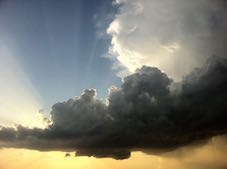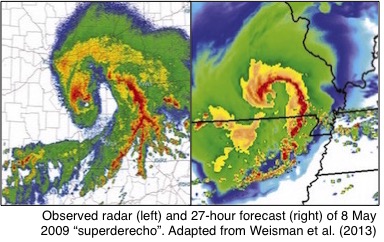

Ryan Sobash
NCAR/MMM, P.O. Box 3000, Boulder, CO 80307-3000
sobash at ucar dot edu
I'm currently affiliated with the National Center for Atmospheric Research (NCAR) in Boulder, CO as a Project Scientist. At NCAR, I work within the data assimilation group in the Mesoscale and Microscale Meteorology (MMM) Laboratory.
Research Interests: Improving forecasts of extreme, high-impact weather, such as severe convection and its associated hazards (tornadoes, high winds, large hail). To do so, I use a suite of tools, including machine learning algorithms, data assimilation, ensemble forecasts, and high-resolution numerical models.
- Research summary

- My interest in predicting convective storms spans many time-scales, from short forecast lead-times to assist in improving warnings, to longer lead-times to improve predictions of storms occurring hours or days into the future.
- Some of the tools I work with include storm-resolving numerical weather prediction models, machine learning algorithms, and ensemble data assimilation methods. Ensemble systems are essential given the many uncertainties that exist with forecasting convective storms.
-
I'm also interesting in developing new forms of forecast guidance to better convey uncertainty information to decision makers. This includes developing products and visualization interfaces using interactive, web-based visualization packages.
- Refereed Publications
- Sobash, R. A., G. S. Romine, and C. S. Schwartz, 2020: A comparison of neural-network and surrogate-severe probabilistic convective hazard guidance derived from a convection-allowing model. Wea. Forecasting, in press.
- Schwartz, C. S., M. Wong, G. S. Romine, R. A. Sobash, and K. R. Fossell, 2020: Initial Conditions for Convection-Allowing Ensembles over the Conterminous United States. Mon. Wea. Rev., 148, 2645-2669.
- Trier, S. B., G. S. Romine, D. A. Ahijevych, and R. A. Sobash, 2019: Lower-tropospheric influences on the timing and intensity of afternoon severe convection over modest terrain in a convection-allowing ensemble. Wea. Forecasting, 34, 1633-1656.
- Schwartz, C. S. and R. A. Sobash, 2019: Revisiting sensitivity to horizontal grid-spacing in convection-allowing models over the central-eastern United States. Mon. Wea. Rev., 147, 4411–4435.
- Sobash, R. A., C. S. Schwartz, M. L. Weisman, and G. S. Romine, 2019: Next-day prediction of tornadoes using convection-allowing models with 1-km grid spacing. Wea. Forecasting, 34 1117-1135.
- Schwartz, C. S., G. S. Romine, R. A. Sobash, K. R. Fossell, and M. L. Weisman, 2019: NCAR’s real-time convection-allowing ensemble project. Bull. of Amer. Meteor. Soc., 100, 321-343.
- Clark, A. J., and Coauthors, 2018: The Community Leveraged Unified Ensemble (CLUE) in the 2016 NOAA/Hazardous Weather Testbed Spring Forecasting Experiment. Bull. of Amer. Meteor. Soc., 99, 1433–1448.
- Sobash, R. A. and J. S. Kain, 2017: Seasonal variations in severe weather forecast skill in an experimental convection-allowing model. Wea. Forecasting, 32, 1885–1902.
- Gagne, D. J., A. McGovern, S. E. Haupt, R. A. Sobash, J. K. Williams, and M. Xue, 2017: Storm-Based Probabilistic Hail Forecasting with Machine Learning Applied to Convection-Allowing Ensembles. Wea. Forecasting, 32, 1819–1840.
- Schwartz, C. S. and R. A. Sobash, 2017: Generating probabilistic forecasts from convection-allowing ensembles using neighborhood approaches: A review and recommendations. Mon. Wea. Rev., 145, 3397–3418
- Schwartz, C. S. and G. S. Romine, K. R. Fossell, R. A. Sobash, and M. L. Weisman, 2017: Toward 1-km ensemble forecasts over large domains. Mon. Wea. Rev., 145, 2943–2969.
- Trier, S. B., J. W. Wilson, D. A. Ahijevych, R. A. Sobash, 2017: Mesoscale Vertical Motions near Nocturnal Convection Initiation in PECAN. Mon. Wea. Rev., 145, 2919–2941.
- Poterjoy, J., R. A. Sobash, and J. L. Anderson, 2017: Convective-scale data assimilation for the Weather Research and Forecasting model using the local particle filter. Mon. Wea. Rev., 145, 1897–1918.
- Sobash, R. A., G. S. Romine, C. S. Schwartz, D. J. Gagne, and M. L. Weisman, 2016: Explicit forecasts of low-level rotation from convection-allowing models for next-day tornado prediction. Wea. Forecasting, 31, 1591-1614.
- Sobash, R. A., C. S. Schwartz, G. S. Romine, K. R. Fossell, and M. L. Weisman, 2016: Severe weather prediction using storm surrogates from an ensemble forecasting system. Wea. Forecasting, 31, 255-271.
- Schwartz, C. S., G. S. Romine, R. A. Sobash, K. R. Fossell, and M. L. Weisman, 2015: NCAR's experimental real-time convection-allowing ensemble prediction system. Wea. Forecasting, 30, 1645-1654.
- Schwartz, C. S., G. S. Romine, M. L. Weisman, R. A. Sobash, K. R. Fossell, K. W. Manning, and S. B. Trier, 2015: A real-time convection-allowing ensemble prediction system initialized by mesoscale ensemble Kalman filter analyses. Wea. Forecasting, 30, 1158–1181.
- Sobash, R. A. and L. J. Wicker, 2015: On the impact of additive noise in storm-scale EnKF experiments, Mon. Wea. Rev., 143, 3067-3086.
- Weisman, M. L. and Coauthors, 2015: The Mesoscale Predictability Experiment (MPEX), Bull. of Amer. Meteor. Soc., 96, 2127–2149.
- Sobash, R. A. and D. J. Stensrud, 2015: Assimilating surface mesonet observations with the EnKF to improve ensemble forecasts of convection initiation, Mon. Wea. Rev., 143, 3700-3725.
- Sobash, R. A. and D. J. Stensrud, 2013: The impact of covariance localization for radar data on enKF analyses of a developing MCS: Observing system simulation experiments. Mon. Wea. Rev., 141, 3691-3709.
- Kain, J. S. and Coauthors, 2013: A feasibility study for probabilistic convection initiation forecasts based on explicit numerical guidance, Bull. of Amer. Meteor. Soc., 94, 1213-1225.
- Clark, A. J., S. J. Weiss, I. L. Jirak, M. Coniglio, C. J. Melick, C. Siewert, R. A. Sobash, and Coauthors, 2012: An Overview of the 2010 Hazardous Weather Testbed Experimental Forecast Program Spring Experiment, Bull. of Amer. Meteor. Soc., 93, 55-74.
- Sobash, R. A., J. S. Kain, D. R. Bright, A. R. Dean, M. C. Coniglio, and S. J. Weiss, 2011: Probabilistic forecast guidance for severe thunderstorms based on the identification of extreme phenomena in convection-allowing model forecasts. Wea. and Forecasting, 26, 714-728.
- Kain, J. S., S. R. Dembek, S. J. Weiss, J. L. Case, J. J. Levit, and R. A. Sobash, 2010: Extracting Unique Information from High Resolution Forecast Models: Monitoring Selected Fields and Phenomena Every Time Step. Wea. and Forecasting, 25, 1536-1542.
- Laird, N., R. Sobash, and N. Hodas, 2010: Climatological Conditions of Lake-Effect Precipitation Events associated with the New York State Finger Lakes.
J. Appl. Meteor. Climatol., 49, 1052-1062.
- Laird, N., R. Sobash, and N. Hodas, 2009: The Frequency and Characteristics of Lake-Effect Precipitation Events Associated with the New York State Finger Lakes. J. Appl. Meteor. Climatol., 48, 873-886.
- Education
- Ph. D. - University of Oklahoma, School of Meteorology, Adviser: Dr. David Stensrud, June 2010 - December 2013
- M.S. - University of Oklahoma, School of Meteorology, Adviser: Dr. Jack Kain, September 2006 - May 2010
- B.S. - The Pennsylvania State University, Major: Meteorology, September 2002 - May 2006
Last Updated: 18 August 2020



